Risk Assessment of Effects of Essential Oils on Honey Bees (Apis mellifera L.)
Simple Summary
Abstract
1. Introduction
2. Materials and Methods
2.1. Honey Bees
2.2. Chemicals
2.3. Bioassays
2.4. Enzyme Assays
2.5. qRT-PCR of Detoxification Genes
2.6. Statistical Analyses
3. Results
3.1. Effects of EcoTec+ on Honey Bees
3.2. Effects of Bisabolene on Honey Bees
3.3. Effects of Cinnamaldehyde on Honey Bees
3.4. Effects of Cineole on Honey Bees
3.5. Effects of Eugenol on Honey Bees
4. Discussion
5. Conclusions
Supplementary Materials
Author Contributions
Funding
Institutional Review Board Statement
Informed Consent Statement
Data Availability Statement
Acknowledgments
Conflicts of Interest
References
- Walsh, T.K.; Heckel, D.G.; Wu, Y.; Downes, S.; Gordon, K.H.J.; Oakeshott, J.G. Determinants of Insecticide Resistance Evolution: Comparative Analysis Among Heliothines. Annu. Rev. Entomol. 2022, 67, 387–406. [Google Scholar] [CrossRef] [PubMed]
- Siddiqui, J.A.; Fan, R.; Naz, H.; Bamisile, B.S.; Hafeez, M.; Ghani, M.I.; Wei, Y.; Xu, Y.; Chen, X. Insights into Insecticide-Resistance Mechanisms in Invasive Species: Challenges and Control Strategies. Front. Physiol. 2023, 13, 1112278. [Google Scholar] [CrossRef]
- Lamberth, C.; Jeanmart, S.; Luksch, T.; Plant, A. Current Challenges and Trends in the Discovery of Agrochemicals. Science 2013, 341, 742–746. [Google Scholar] [CrossRef]
- Zhu, Y.C.; Adamczyk, J.; Rinderer, T.; Yao, J.; Danka, R.; Luttrell, R.; Gore, J. Spray Toxicity and Risk Potential of 42 Commonly Used Formulations of Row Crop Pesticides to Adult Honey Bees (Hymenoptera: Apidae). J. Econ. Entomol. 2015, 108, 2640–2647. [Google Scholar] [CrossRef]
- Carvalho, F.P. Pesticides, Environment, and Food Safety. Food Energy Secur. 2017, 6, 48–60. [Google Scholar] [CrossRef]
- Rattner, B.A.; Bean, T.G.; Beasley, V.R.; Berny, P.; Eisenreich, K.M.; Elliott, J.E.; Eng, M.L.; Fuchsman, P.C.; King, M.D.; Mateo, R.; et al. Wildlife Ecological Risk Assessment in the 21st Century: Promising Technologies to Assess Toxicological Effects. Integr. Environ. Assess. Manag. 2024, 20, 725–748. [Google Scholar] [CrossRef] [PubMed]
- Goulson, D. REVIEW: An Overview of the Environmental Risks Posed by Neonicotinoid Insecticides. J. Appl. Ecol. 2013, 50, 977–987. [Google Scholar] [CrossRef]
- Bakkali, F.; Averbeck, S.; Averbeck, D.; Idaomar, M. Biological Effects of Essential Oils—A Review. Food Chem. Toxicol. 2008, 46, 446–475. [Google Scholar] [CrossRef]
- Ayllón-Gutiérrez, R.; López-Maldonado, E.A.; Macías-Alonso, M.; González Marrero, J.; Díaz-Rubio, L.; Córdova-Guerrero, I. Evaluation of the Stability of a 1,8-Cineole Nanoemulsion and Its Fumigant Toxicity Effect against the Pests Tetranychus urticae, Rhopalosiphum maidis and Bemisia tabaci. Insects 2023, 14, 663. [Google Scholar] [CrossRef]
- Visakh, N.U.; Pathrose, B.; Chellappan, M.; Ranjith, M.T.; Sindhu, P.V.; Mathew, D. Extraction and Chemical Characterisation of Agro-Waste from Turmeric Leaves as a Source of Bioactive Essential Oils with Insecticidal and Antioxidant Activities. Waste Manag. 2023, 169, 1–10. [Google Scholar] [CrossRef]
- Gupta, I.; Singh, R.; Muthusamy, S.; Sharma, M.; Grewal, K.; Singh, H.P.; Batish, D.R. Plant Essential Oils as Biopesticides: Applications, Mechanisms, Innovations, and Constraints. Plants 2023, 12, 2916. [Google Scholar] [CrossRef] [PubMed]
- Gaire, S.; Zheng, W.; Scharf, M.E.; Gondhalekar, A.D. Plant Essential Oil Constituents Enhance Deltamethrin Toxicity in a Resistant Population of Bed Bugs (Cimex lectularius L.) by Inhibiting Cytochrome P450 Enzymes. Pestic. Biochem. Physiol. 2021, 175, 104829. [Google Scholar] [CrossRef]
- Chansang, A.; Champakaew, D.; Junkum, A.; Jitpakdi, A.; Amornlerdpison, D.; Aldred, A.K.; Riyong, D.; Wannasan, A.; Intirach, J.; Muangmoon, R.; et al. Synergy in the Adulticidal Efficacy of Essential Oils for the Improvement of Permethrin Toxicity against Aedes aegypti L. (Diptera: Culicidae). Parasites Vectors 2018, 11, 417. [Google Scholar] [CrossRef]
- Giatropoulos, A.; Koliopoulos, G.; Pantelakis, P.-N.; Papachristos, D.; Michaelakis, A. Evaluating the Sublethal Effects of Origanum vulgare Essential Oil and Carvacrol on the Biological Characteristics of Culex pipiens Biotype Molestus (Diptera: Culicidae). Insects 2023, 14, 400. [Google Scholar] [CrossRef]
- Johnson, E.J.; McComic, S.E.; Rault, L.C.; Swale, D.R.; Anderson, T.D. Bioinsecticidal Activity of Cajeput Oil to Pyrethroid-Susceptible and -Resistant Mosquitoes. Pestic. Biochem. Physiol. 2023, 193, 105458. [Google Scholar] [CrossRef] [PubMed]
- Mustapa, M.A.; Guswenrivo, I.; Zurohtun, A.; Khairul Ikram, N.K.; Muchtaridi, M. Analysis of Essential Oils Components from Aromatic Plants Using Headspace Repellent Method against Aedes aegypti Mosquitoes. Molecules 2023, 28, 4269. [Google Scholar] [CrossRef]
- Sanei-Dehkordi, A.; Ghasemian, A.; Zarenezhad, E.; Qasemi, H.; Nasiri, M.; Osanloo, M. Nanoliposomes Containing Three Essential Oils from the Artemisia Genus as Effective Larvicides against Aedes aegypti and Anopheles stephensi. Sci. Rep. 2023, 13, 11002. [Google Scholar] [CrossRef] [PubMed]
- Rants’o, T.A.; Koekemoer, L.L.; Van Zyl, R.L. Bioactivity of Select Essential Oil Constituents against Life Stages of Anopheles arabiensis (Diptera: Culicidae). Exp. Parasitol. 2023, 251, 108569. [Google Scholar] [CrossRef]
- Demeter, S.; Lebbe, O.; Hecq, F.; Nicolis, S.C.; Kenne Kemene, T.; Martin, H.; Fauconnier, M.-L.; Hance, T. Insecticidal Activity of 25 Essential Oils on the Stored Product Pest, Sitophilus granarius. Foods 2021, 10, 200. [Google Scholar] [CrossRef]
- Izdebska, A.M.; Kłyś, M.; Nowak-Chmura, M.; Koczanowicz, S. Lower Dose of Plant Substance More Effective in Repelling Rhyzopertha dominica F. (Coleoptera, Bostrichidae) and Sitophilus granarius L. (Coleoptera, Dryophthoridae). Ann. Agric. Environ. Med. 2023, 30, 407–412. [Google Scholar] [CrossRef]
- Reynoso, M.M.N.; Lucia, A.; Zerba, E.N.; Alzogaray, R.A. Eugenol-Hyperactivated Nymphs of Triatoma Infestans Become Intoxicated Faster than Non-Hyperactivated Nymphs When Exposed to a Permethrin-Treated Surface. Parasites Vectors 2018, 11, 573. [Google Scholar] [CrossRef] [PubMed]
- Alimi, D.; Hajri, A.; Jallouli, S.; Sebai, H. Pistacia Lentiscus Essential Oil and Its Pure Active Components as Acaricides to Control Dermanyssus gallinae (Acari: Mesostigmata). Vet. Parasitol. 2023, 322, 110028. [Google Scholar] [CrossRef] [PubMed]
- Ferrati, M.; Spinozzi, E.; Baldassarri, C.; Maggi, F.; Pavela, R.; Canale, A.; Petrelli, R.; Cappellacci, L. Efficacy of Mentha aquatica L. Essential Oil (Linalool/Linalool Acetate Chemotype) against Insect Vectors and Agricultural Pests. Pharmaceuticals 2023, 16, 633. [Google Scholar] [CrossRef] [PubMed]
- Xu, J.; Lv, M.; Fang, S.; Wang, Y.; Wen, H.; Zhang, S.; Xu, H. Exploration of Synergistic Pesticidal Activities, Control Effects and Toxicology Study of a Monoterpene Essential Oil with Two Natural Alkaloids. Toxins 2023, 15, 240. [Google Scholar] [CrossRef]
- Casas, J.L.; Sagarduy-Cabrera, A.; López Santos-Olmo, M.; Marcos-García, M.Á. Essential Oils from Selected Mediterranean Aromatic Plants—Characterization and Biological Activity as Aphid biopesticides. Life 2023, 13, 1621. [Google Scholar] [CrossRef]
- Perumal, V.; Kannan, S.; Pittarate, S.; Chinnasamy, R.; Krutmuang, P. Essential Oils from Acacia Nilotica (Fabales: Fabaceae) Seeds: May Have Insecticidal Effects? Heliyon 2023, 9, e14808. [Google Scholar] [CrossRef]
- Yoon, J.; Tak, J.-H. Cuticular Property Affects the Insecticidal Synergy of Major Constituents in Thyme Oil against Houseflies, Musca domestica. Sci. Rep. 2023, 13, 12654. [Google Scholar] [CrossRef]
- Moustafa, M.A.M.; Hassan, N.N.; Alfuhaid, N.A.; Amer, A.; Awad, M. Insights into the Toxicity, Biochemical Activity, and Molecular Docking of Cymbopogon citratus Essential Oils and Citral on Spodoptera littoralis (Lepidoptera: Noctuidae). J. Econ. Entomol. 2023, 116, 1185–1195. [Google Scholar] [CrossRef]
- Fu, J.; Ma, Z.; Wang, L.; Zhang, Y.; Luo, Y. Fumigant Toxicity and Behavioral Alterations of Six Plant Essential Oils against the Red Fire Ant (Solenopsis invicta Buren). Environ. Sci. Pollut. Res. 2023, 30, 68677–68690. [Google Scholar] [CrossRef]
- Shah, F.M.; Guddeti, D.K.; Paudel, P.; Chen, J.; Li, X.-C.; Khan, I.A.; Ali, A. Matricaria chamomilla Essential Oils: Repellency and Toxicity against Imported Fire Ants (Hymenoptera: Formicidae). Molecules 2023, 28, 5584. [Google Scholar] [CrossRef]
- Li, M.; Feng, S.; Huang, S.; Guillot, J.; Fang, F. In Vitro Efficacy of Terpenes from Essential Oils against Sarcoptes scabiei. Molecules 2023, 28, 3361. [Google Scholar] [CrossRef] [PubMed]
- Pei, T.-H.; Zhao, Y.-J.; Wang, S.-Y.; Li, X.-F.; Sun, C.-Q.; Shi, S.-S.; Xu, M.-L.; Gao, Y. Preliminary Study on Insecticidal Potential and Chemical Composition of Five Rutaceae Essential Oils against Thrips flavus (Thysanoptera: Thripidae). Molecules 2023, 28, 2998. [Google Scholar] [CrossRef] [PubMed]
- Do Rosário, C.J.R.M.; Lima, A.S.; Mendonça, C.D.J.S.; Soares, I.S.; Júnior, E.B.A.; Gomes, M.N.; Costa-Junior, L.M.; Maia, J.G.S.; Da Rocha, C.Q. Essential Oil Ageratum conyzoides Chemotypes and Anti-Tick Activities. Vet. Parasitol. 2023, 319, 109942. [Google Scholar] [CrossRef]
- Silva, I.S.; Vale, L.; Coutinho, A.L.; Sousa, L.J.M.P.E.; Marchesini, P.; Da Silva Matos, R.; Anholeto, L.A.; Mathias, M.I.C.; Ferreira, L.L.; Arruda, W.; et al. Thymol and Eugenol against Rhipicephalus sanguineus Sensu Lato Engorged Females: Biological, Histopathological and Bioinformatic Analysis. Vet. Parasitol. 2023, 319, 109938. [Google Scholar] [CrossRef] [PubMed]
- Teixeira, A.L.C.; Marreto, L.C.N.L.; Vale, F.L.; Sousa, L.J.M.P.E.; Gonzaga, B.C.F.; Silva, I.S.; Santos, E.F.; Da Silva Lopes, F.F.; De Morais, S.M.; Lopes, W.D.Z.; et al. Combinations of Amitraz with Essential Oils from Lippia sidoides and Thymus vulgaris, Thymol and Thymol Acetate for Rhipicephalus microplus Control: Studies under Laboratory and Field Conditions. Vet. Parasitol. 2023, 321, 109997. [Google Scholar] [CrossRef]
- Tan, W.; Zhang, N.; Wang, J.; Pu, T.; Hu, J.; Li, C.; Song, Y. Fumigant Activity and Transcriptomic Analysis of Two Plant Essential Oils against the Tea Green Leafhopper, Empoasca onukii Matsuda. Front. Physiol. 2023, 14, 1217608. [Google Scholar] [CrossRef]
- Zhang, W.; Zhang, Z.; Li, C.; Yu, X.; He, Q.; You, C.; Li, D.; Liu, Q.; Zhang, J. Sesquiterpenes from Two Compositae Plants as Promising Inhibitors to Nuclear Hormone Receptor 3 of Tribolium castaneum. Pestic. Biochem. Physiol. 2023, 195, 105578. [Google Scholar] [CrossRef]
- Xie, Q.-H.; Liang, T.; Li, B.-Y.; Yu, J.-N.; Zheng, Y.; Du, S.-S.; Borjigidai, A. Bioactivities of Thymol and P-Cymene from the Essential Oil of Adenosma buchneroides against Three Stored-Product Insects. Environ. Sci. Pollut. Res. 2023, 30, 110841–110850. [Google Scholar] [CrossRef]
- Lu, L.; Shu, C.; Chen, L.; Yang, Y.; Ma, S.; Zhu, K.; Shi, B. Insecticidal Activity and Mechanism of Cinnamaldehyde in C. Elegans. Fitoterapia 2020, 146, 104687. [Google Scholar] [CrossRef]
- Cui, K.; He, Y.; Wang, M.; Li, M.; Jiang, C.; Wang, M.; He, L.; Zhang, F.; Zhou, L. Antifungal Activity of Ligusticum chuanxiong Essential Oil and Its Active Composition Butylidenephthalide against Sclerotium rolfsii. Pest Manag. Sci. 2023, 79, 5374–5386. [Google Scholar] [CrossRef]
- Paramalingam, P.; Baharum, N.A.; Abdullah, J.O.; Hong, J.K.; Saidi, N.B. Antifungal Potential of Melaleuca alternifolia against Fungal Pathogen Fusarium Oxysporum f. Sp. Cubense Tropical Race 4. Molecules 2023, 28, 4456. [Google Scholar] [CrossRef] [PubMed]
- Machado, S.; Pereira, R.; Sousa, R.M.O.F. Nanobiopesticides: Are They the Future of Phytosanitary Treatments in Modern Agriculture? Sci. Total Environ. 2023, 896, 166401. [Google Scholar] [CrossRef] [PubMed]
- Khajehali, J.; Poorjavad, N.; Bolandnazar, A.; Shahim-Germi, F.; Kimiaie, M.; Ardestani, M.M. Efficiency of Plant-Based Acaricide Gels Compared to Fluvalinate-Impregnated Strips for Control of Varroa destructor in Honey Bee Colonies. Exp. Appl. Acarol. 2023, 91, 57–67. [Google Scholar] [CrossRef] [PubMed]
- Narciso, L.; Topini, M.; Ferraiuolo, S.; Ianiro, G.; Marianelli, C. Effects of Natural Treatments on the Varroa Mite Infestation Levels and Overall Health of Honey Bee (Apis mellifera) Colonies. PLoS ONE 2024, 19, e0302846. [Google Scholar] [CrossRef]
- Bava, R.; Castagna, F.; Lupia, C.; Ruga, S.; Conforti, F.; Marrelli, M.; Argentieri, M.P.; Musella, V.; Britti, D.; Statti, G.; et al. Phytochemical Composition and Pharmacological Efficacy Evaluation of Calamintha nepeta, Calamintha sylvatica, Lavandula austroapennina and Mentha piperita Essential Oils for the Control of Honeybee (Apis mellifera) Varroosis. Animals 2023, 14, 69. [Google Scholar] [CrossRef]
- Alsaadi, M.; Keshlaf, M.; Mirwan, H. Some Essential Oils as Potential Control Agents for Varroa Mite (Varroa destructor) in Infected Honey Bees (Apis mellifera). Open Vet. J. 2024, 14, 692–698. [Google Scholar] [CrossRef]
- Ariana, A.; Ebadi, R.; Tahmasebi, G. Laboratory Evaluation of Some Plant Essences to Control Varroa destructor (Acari: Varroidae). Exp. Appl. Acarol. 2002, 27, 319–327. [Google Scholar] [CrossRef]
- Alahyane, H.; Ouknin, M.; Aboussaid, H.; El Messoussi, S.; Costa, J.; Majidi, L. Biological Activities of Essential Oils from Moroccan Plants against the Honey Bee Ectoparasitic Mite, Varroa destructor. Int. J. Acarol. 2022, 48, 50–56. [Google Scholar] [CrossRef]
- Da Silva, I.M.; Zanuncio, J.C.; Brügger, B.P.; Soares, M.A.; Zanuncio, A.J.V.; Wilcken, C.F.; Tavares, W.D.S.; Serrão, J.E.; Sediyama, C.S. Selectivity of the Botanical Compounds to the Pollinators Apis mellifera and Trigona Hyalinata (Hymenoptera: Apidae). Sci. Rep. 2020, 10, 4820. [Google Scholar] [CrossRef]
- Giménez-Martínez, P.; Ramirez, C.; Mitton, G.; Arcerito, F.M.; Ramos, F.; Cooley, H.; Fuselli, S.; Maggi, M. Lethal Concentrations of Cymbopogon Nardus Essential Oils and Their Main Component Citronellal on Varroa destructor and Apis mellifera. Exp. Parasitol. 2022, 238, 108279. [Google Scholar] [CrossRef]
- Ewert, A.M.; Simone-Finstrom, M.; Read, Q.; Husseneder, C.; Ricigliano, V. Effects of Ingested Essential Oils and Propolis Extracts on Honey Bee (Hymenoptera: Apidae) Health and Gut Microbiota. J. Insect Sci. 2023, 23, 15. [Google Scholar] [CrossRef] [PubMed]
- Conti, B.; Bocchino, R.; Cosci, F.; Ascrizzi, R.; Flamini, G.; Bedini, S. Essential Oils against Varroa destructor: A Soft Way to Fight the Parasitic Mite of Apis mellifera. J. Apic. Res. 2020, 59, 774–782. [Google Scholar] [CrossRef]
- Gostin, I.N.; Popescu, I.E. Evaluation of the Essential Oils Used in the Production of Biopesticides: Assessing Their Toxicity toward Both Arthropod Target Species and Beneficial Pollinators. Agriculture 2023, 14, 81. [Google Scholar] [CrossRef]
- Crow, W.; Cook, D.; Musser, F.; Towles, T. 2025 Insect Control Guide for Agronomic Crops; Mississippi State University: Mississippi State, MS, USA, 2025. [Google Scholar]
- Narayanankutty, A.; Kunnath, K.; Alfarhan, A.; Rajagopal, R.; Ramesh, V. Chemical Composition of Cinnamomum verum Leaf and Flower Essential Oils and Analysis of Their Antibacterial, Insecticidal, and Larvicidal Properties. Molecules 2021, 26, 6303. [Google Scholar] [CrossRef] [PubMed]
- Zhu, Y.C.; Yao, J.; Adamczyk, J.; Luttrell, R. Feeding Toxicity and Impact of Imidacloprid Formulation and Mixtures with Six Representative Pesticides at Residue Concentrations on Honey Bee Physiology (Apis mellifera). PLoS ONE 2017, 12, e0178421. [Google Scholar] [CrossRef]
- Yao, J.; Zhu, Y.C.; Adamczyk, J. Responses of Honey Bees to Lethal and Sublethal Doses of Formulated Clothianidin Alone and Mixtures. J. Econ. Entomol. 2018, 111, 1517–1525. [Google Scholar] [CrossRef]
- Mao, W.; Schuler, M.A.; Berenbaum, M.R. CYP9Q-Mediated Detoxification of Acaricides in the Honey Bee (Apis mellifera). Proc. Natl. Acad. Sci. USA 2011, 108, 12657–12662. [Google Scholar] [CrossRef]
- Karunarathne, P.; Pocquet, N.; Labbé, P.; Milesi, P. BioRssay: An R Package for Analyses of Bioassays and Probit Graphs. Parasites Vectors 2022, 15, 35. [Google Scholar] [CrossRef]
- Abbott, W.S. A Method of Computing the Effectiveness of an Insecticide. J. Econ. Entomol. 1925, 18, 265–267. [Google Scholar] [CrossRef]
- U.S. Environmental Protection Agency. Appendix I. Toxicity Categories and LOCs; U.S. Environmental Protection Agency: Washington, DC, USA, 2008. [Google Scholar]
- Begna, T.; Ulziibayar, D.; Bisrat, D.; Jung, C. Acaricidal Toxicity of Four Essential Oils, Their Predominant Constituents, Their Mixtures against Varroa Mite, and Their Selectivity to Honey Bees (Apis cerana and A. Mellifera). Insects 2023, 14, 735. [Google Scholar] [CrossRef]
- Santos, A.C.C. Óleo Essencial de Cymbopogon martinii e seu Constituinte Majoritário Geraniol: Influência na Mortalidade e Comportamento de Apis mellifera (Apidae); Universidade Federal de Sergipe: São Cristóvão, Sergipe, Brazil, 2017. [Google Scholar]
- Youssef, D.A.A.; Abdelmegeed, S.M. Polymer-Based Encapsulation of Peppermint Oil (Mentha piperita) Nanoemulsion and Its Effects on Life and Some Physiological Activities of Honeybees Apis mellifera (Hymenoptera: Apidae). Egypt. Pharm. J. 2021, 20, 313–322. [Google Scholar] [CrossRef]
- Govindarajan, M.; Vaseeharan, B.; Alharbi, N.S.; Kadaikunnan, S.; Khaled, J.M.; Al-anbr, M.N.; Alyahya, S.A.; Maggi, F.; Benelli, G. High Efficacy of (Z)-γ-Bisabolene from the Essential Oil of Galinsoga Parviflora (Asteraceae) as Larvicide and Oviposition Deterrent against Six Mosquito Vectors. Environ. Sci. Pollut. Res. 2018, 25, 10555–10566. [Google Scholar] [CrossRef]
- Kim, S.; Kim, K.; Lee, J.H.; Han, S.H.; Lee, S.H. Differential Expression of Acetylcholinesterase 1 in Response to Various Stress Factors in Honey Bee Workers. Sci. Rep. 2019, 9, 10342. [Google Scholar] [CrossRef] [PubMed]
- Palmer-Young, E.C.; Markowitz, L.M.; Grubbs, K.; Zhang, Y.; Corona, M.; Schwarz, R.; Chen, Y.; Evans, J.D. Antiparasitic Effects of Three Floral Volatiles on Trypanosomatid Infection in Honey Bees. J. Invertebr. Pathol. 2022, 194, 107830. [Google Scholar] [CrossRef] [PubMed]
- Ebert, T.A.; Kevan, P.G.; Bishop, B.L.; Kevan, S.D.; Downer, R.A. Oral Toxicity of Essential Oils and Organic Acids Fed to Honey Bees (Apis mellifera). J. Apic. Res. 2007, 46, 220–224. [Google Scholar] [CrossRef]
- Cruz-Castillo, A.U.; Rodríguez-Valdez, L.M.; Correa-Basurto, J.; Nogueda-Torres, B.; Andrade-Ochoa, S.; Nevárez-Moorillón, G.V. Terpenic Constituents of Essential Oils with Larvicidal Activity against Aedes aegypti: A QSAR and Docking Molecular Study. Molecules 2023, 28, 2454. [Google Scholar] [CrossRef]
- Caputo, L.; Capozzolo, F.; Amato, G.; De Feo, V.; Fratianni, F.; Vivenzio, G.; Nazzaro, F. Chemical Composition, Antibiofilm, Cytotoxic, and Anti-Acetylcholinesterase Activities of Myrtus communis L. Leaves Essential Oil. BMC Complement. Med. Ther. 2022, 22, 142. [Google Scholar] [CrossRef]
- Perry, N.S.L.; Houghton, P.J.; Theobald, A.; Jenner, P.; Perry, E.K. In-Vitro Inhibition of Human Erythrocyte Acetylcholinesterase by Salvia Lavandulaefolia Essential Oil and Constituent Terpenes. J. Pharm. Pharmacol. 2000, 52, 895–902. [Google Scholar] [CrossRef]
- Enan, E. Insecticidal Activity of Essential Oils: Octopaminergic Sites of Action. Comp. Biochem. Physiol. Part C Toxicol. Pharmacol. 2001, 130, 325–337. [Google Scholar] [CrossRef]
- Khanikor, B.; Parida, P.; Yadav, R.N.S.; Bora, D. Comparative Mode of Action of Some Terpene Compounds against Octopamine Receptor and Acetyl Cholinesterase of Mosquito and Human System by the Help of Homology Modeling and Docking Studies. J. Appl. Pharm. Sci. 2013, 3, 6–12. [Google Scholar] [CrossRef]
- Klassen, S.S.; VanBlyderveen, W.; Eccles, L.; Kelly, P.G.; Borges, D.; Goodwin, P.H.; Petukhova, T.; Wang, Q.; Guzman-Novoa, E. Nosema Ceranae Infections in Honey Bees (Apis mellifera) Treated with Pre/Probiotics and Impacts on Colonies in the Field. Vet. Sci. 2021, 8, 107. [Google Scholar] [CrossRef] [PubMed]
- Hikal, W.M.; Baeshen, R.S.; Said-Al Ahl, H.A.H. Botanical Insecticide as Simple Extractives for Pest Control. Cogent Biol. 2017, 3, 1404274. [Google Scholar] [CrossRef]
- Younsi, F.; Trimech, R.; Boulila, A.; Ezzine, O.; Dhahri, S.; Boussaid, M.; Messaoud, C. Essential Oil and Phenolic Compounds of Artemisia Herba-Alba (Asso.): Composition, Antioxidant, Antiacetylcholinesterase, and Antibacterial Activities. Int. J. Food Prop. 2016, 19, 1425–1438. [Google Scholar] [CrossRef]
- Calva, J.; Silva, M.; Morocho, V. Composition and Anti-Acetylcholinesterase Properties of the Essential Oil of the Ecuadorian Endemic Species Eugenia Valvata McVaugh. Molecules 2023, 28, 8112. [Google Scholar] [CrossRef]
- Rizvi, S.A.H.; Ling, S.; Tian, F.; Xie, F.; Zeng, X. Toxicity and Enzyme Inhibition Activities of the Essential Oil and Dominant Constituents Derived from Artemisia absinthium L. against Adult Asian Citrus Psyllid Diaphorina citri Kuwayama (Hemiptera: Psyllidae). Ind. Crops Prod. 2018, 121, 468–475. [Google Scholar] [CrossRef]
- Boncristiani, H.; Underwood, R.; Schwarz, R.; Evans, J.D.; Pettis, J.; van Engelsdorp, D. Direct Effect of Acaricides on Pathogen Loads and Gene Expression Levels in Honey Bees Apis mellifera. J. Insect Physiol. 2012, 58, 613–620. [Google Scholar] [CrossRef]
- Gashout, H.A.; Goodwin, P.H.; Guzman-Novoa, E. Lethality of Synthetic and Natural Acaricides to Worker Honey Bees (Apis mellifera) and Their Impact on the Expression of Health and Detoxification-Related Genes. Environ. Sci. Pollut. Res. 2018, 25, 34730–34739. [Google Scholar] [CrossRef]
- Mao, W.; Rupasinghe, S.G.; Johnson, R.M.; Zangerl, A.R.; Schuler, M.A.; Berenbaum, M.R. Quercetin-Metabolizing CYP6AS Enzymes of the Pollinator Apis mellifera (Hymenoptera: Apidae). Comp. Biochem. Physiol. Part B Biochem. Mol. Biol. 2009, 154, 427–434. [Google Scholar] [CrossRef]
- Rants’o, T.A.; Koekemoer, L.L.; Van Zyl, R.L. The Insecticidal Activity of Essential Oil Constituents against Pyrethroid-Resistant Anopheles funestus (Diptera: Culicidae). Parasitol. Int. 2023, 95, 102749. [Google Scholar] [CrossRef]
- Mattila, H.R.; Seeley, T.D. Genetic Diversity in Honey Bee Colonies Enhances Productivity and Fitness. Science 2007, 317, 362–364. [Google Scholar] [CrossRef]
- Rossini, C.; Rodrigo, F.; Davyt, B.; Umpiérrez, M.L.; González, A.; Garrido, P.M.; Cuniolo, A.; Porrini, L.P.; Eguaras, M.J.; Porrini, M.P. Sub-Lethal Effects of the Consumption of Eupatorium buniifolium Essential Oil in Honeybees. PLoS ONE 2020, 15, e0241666. [Google Scholar] [CrossRef] [PubMed]
- Sabahi, Q.; Gashout, H.; Kelly, P.G.; Guzman-Novoa, E. Continuous Release of Oregano Oil Effectively and Safely Controls Varroa destructor Infestations in Honey Bee Colonies in a Northern Climate. Exp. Appl. Acarol. 2017, 72, 263–275. [Google Scholar] [CrossRef] [PubMed]
- Turek, C.; Stintzing, F.C. Stability of Essential Oils: A Review. Comp. Rev. Food Sci. Food Safe 2013, 12, 40–53. [Google Scholar] [CrossRef]
- U.S. Environmental Protection Agency. Series 880-Biochemicals Test Guidelines; U.S. Environmental Protection Agency: Washington, DC, USA, 1996. [Google Scholar]


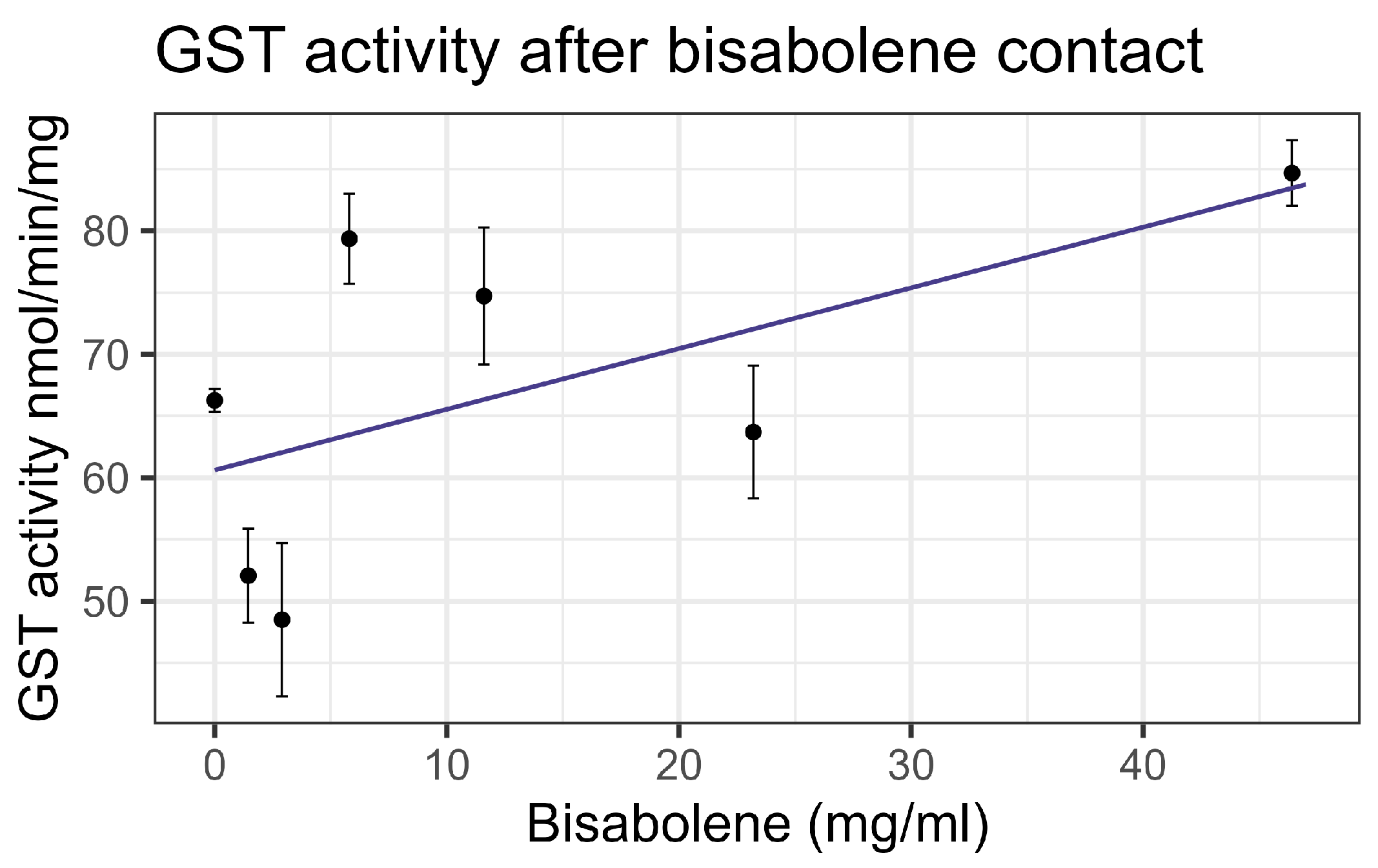
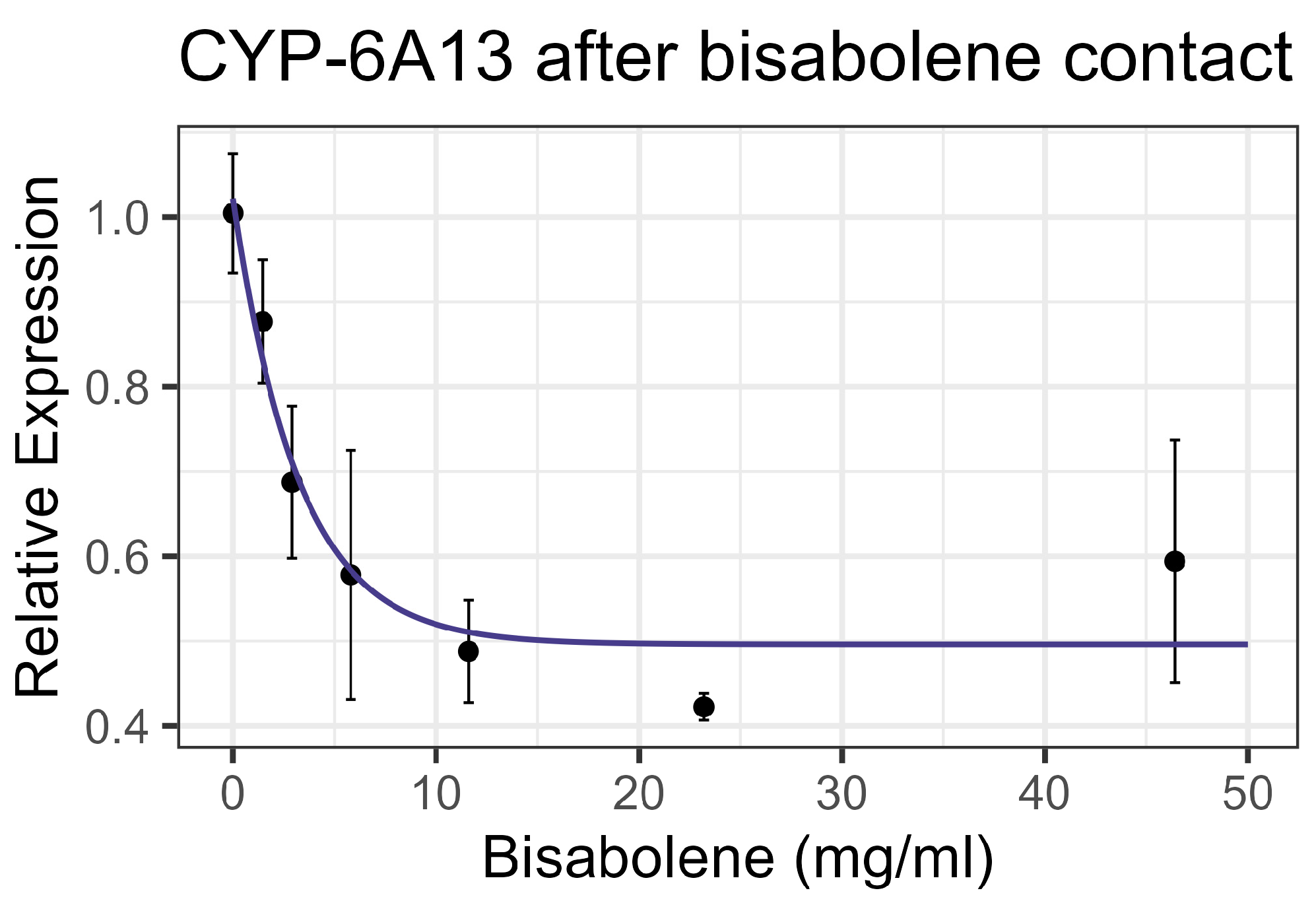
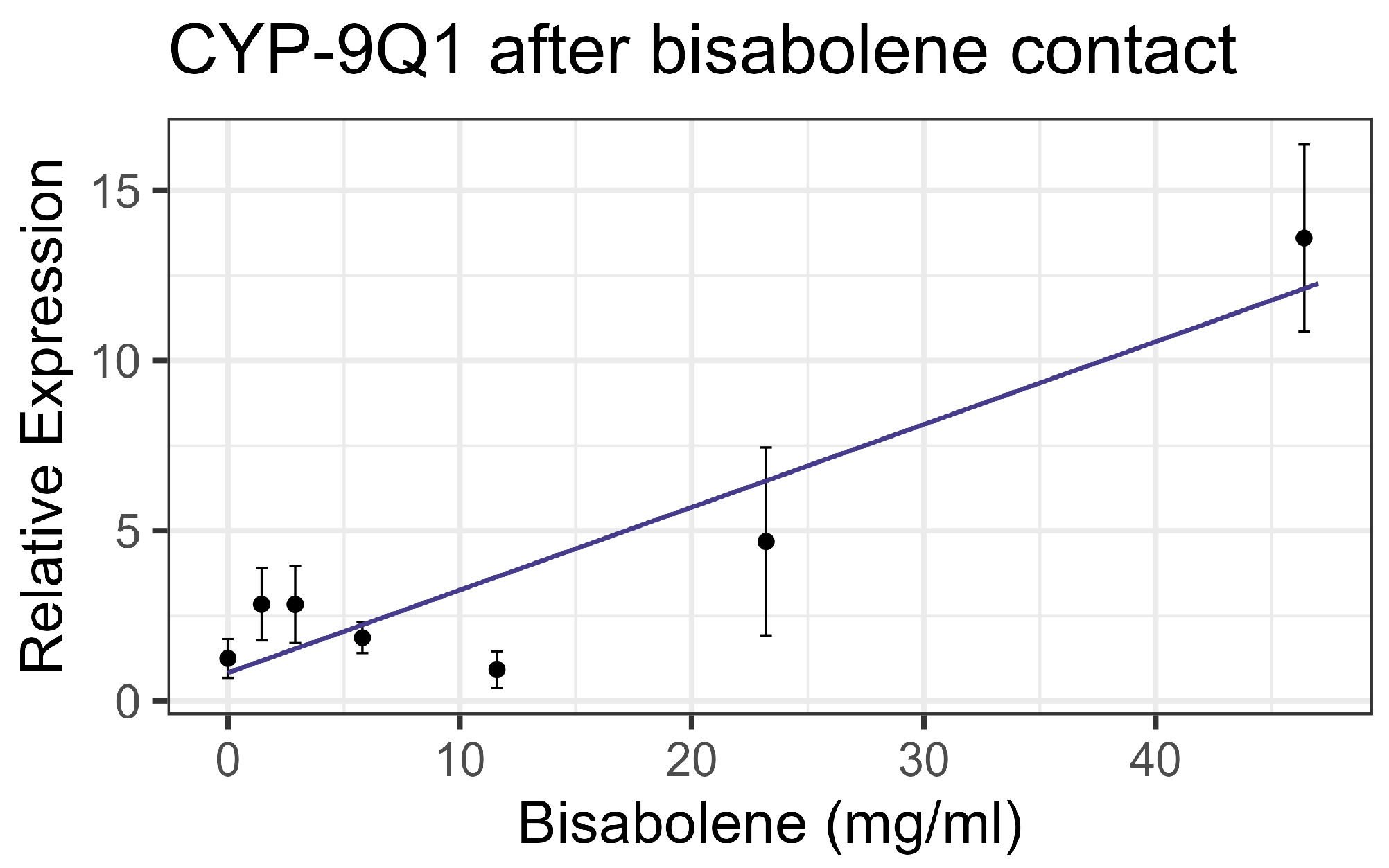
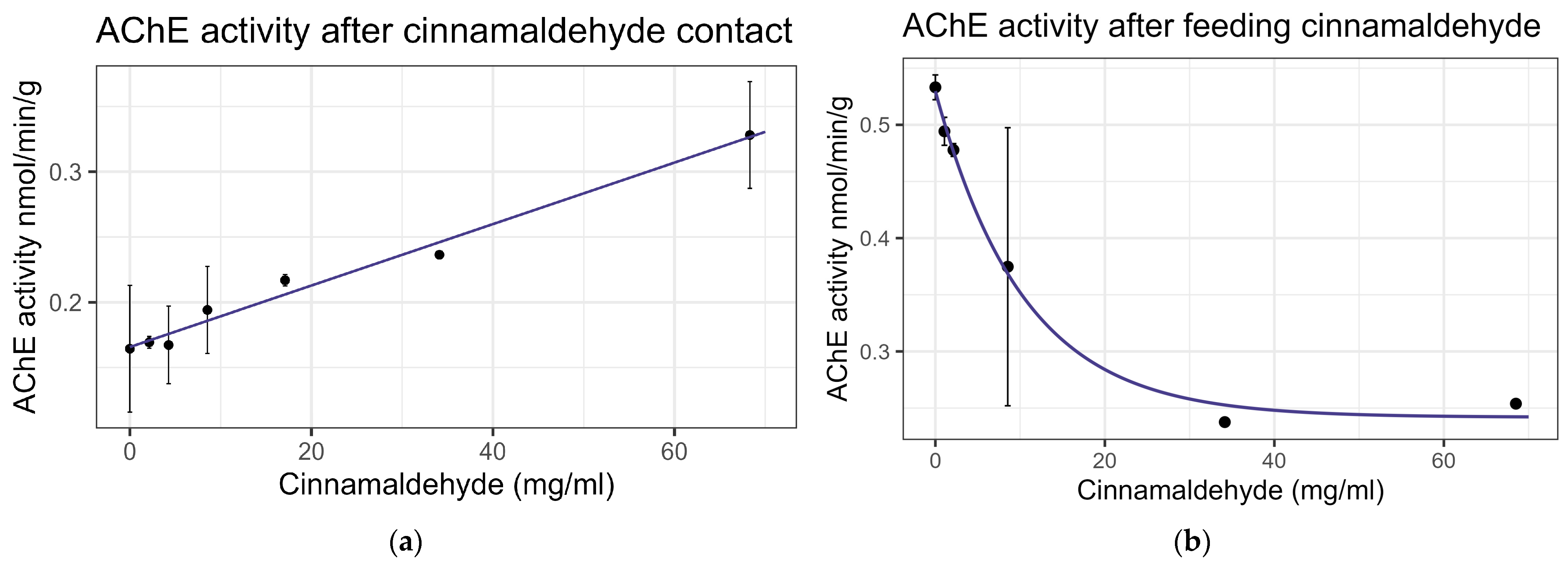
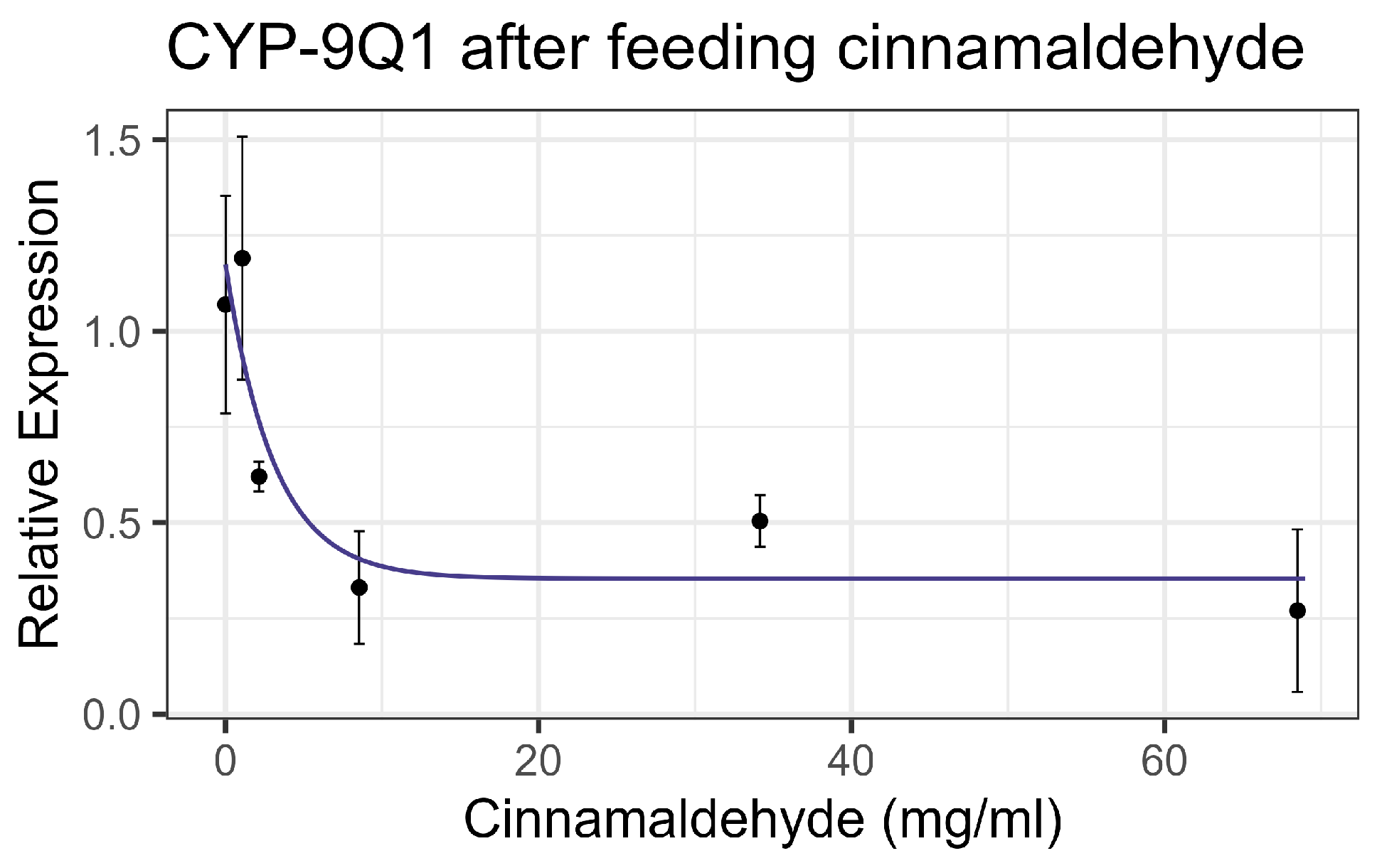
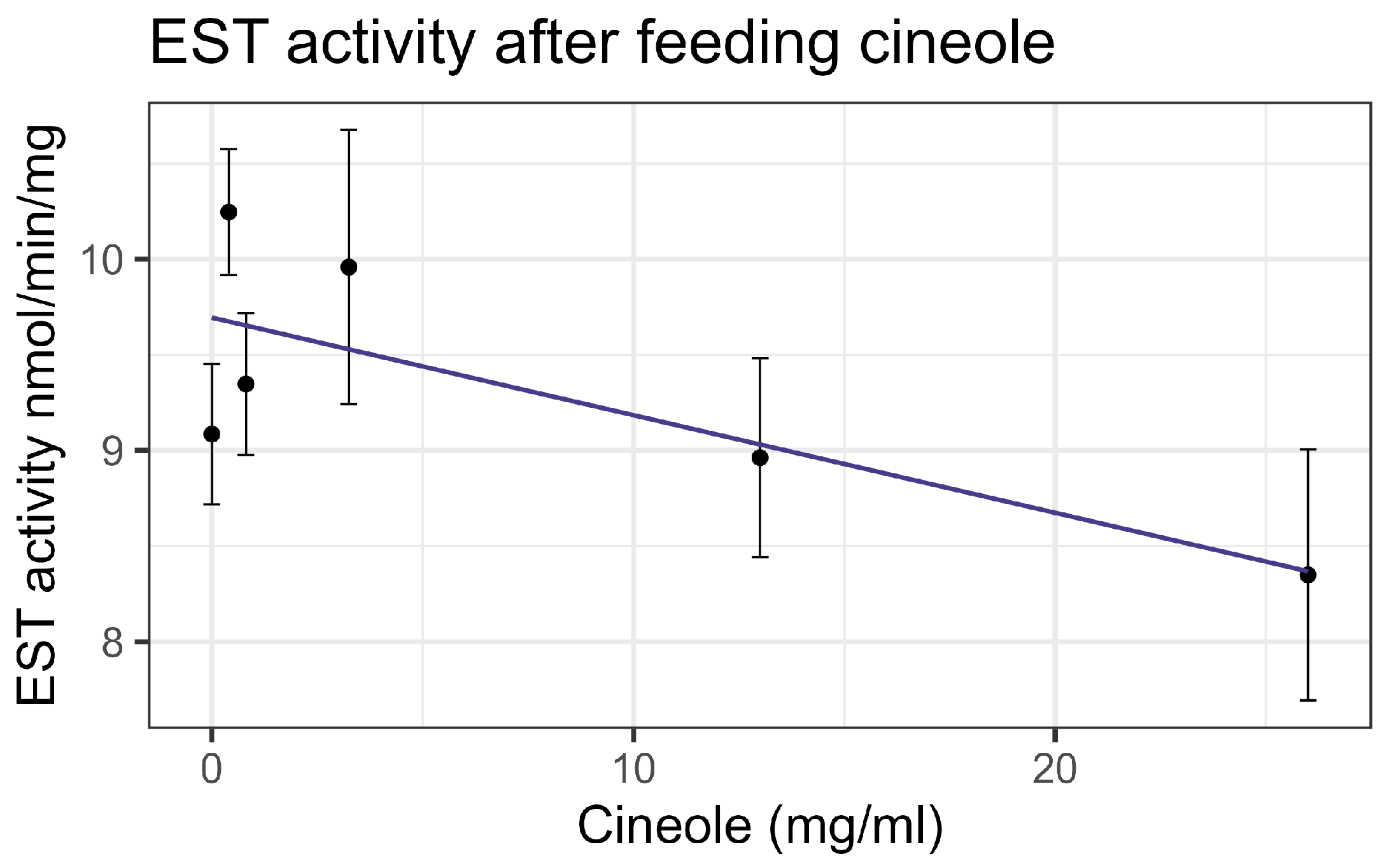

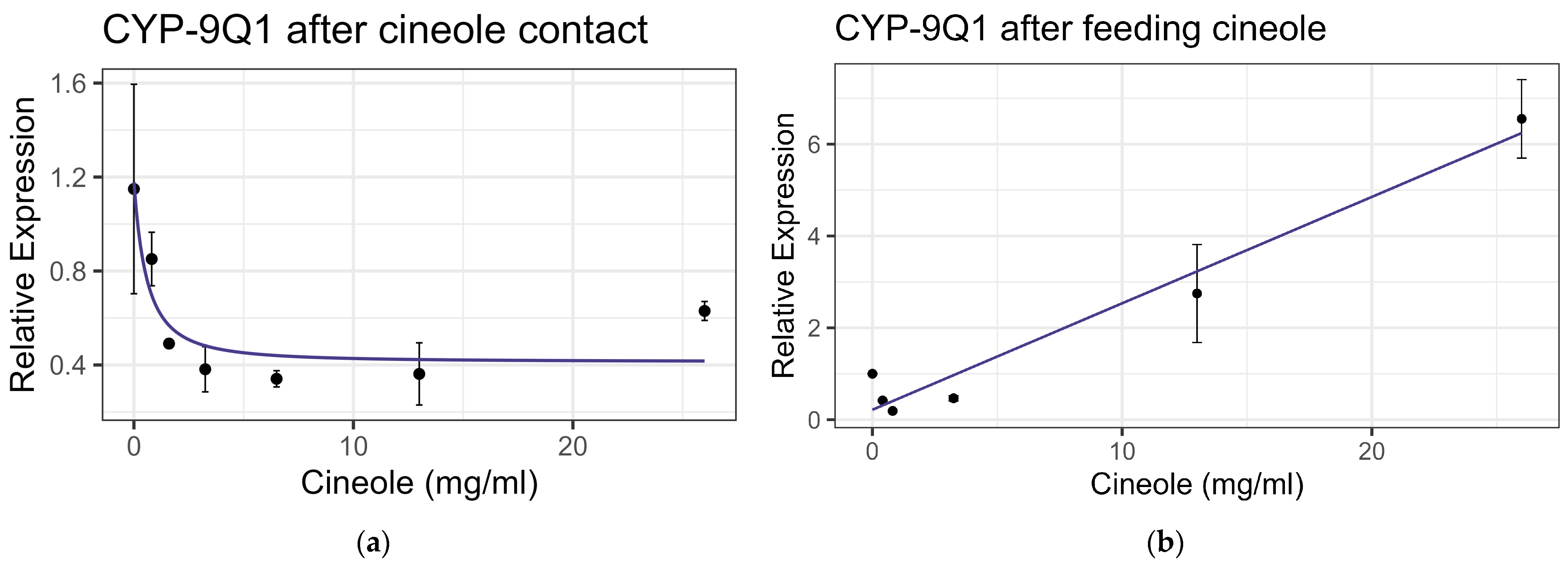
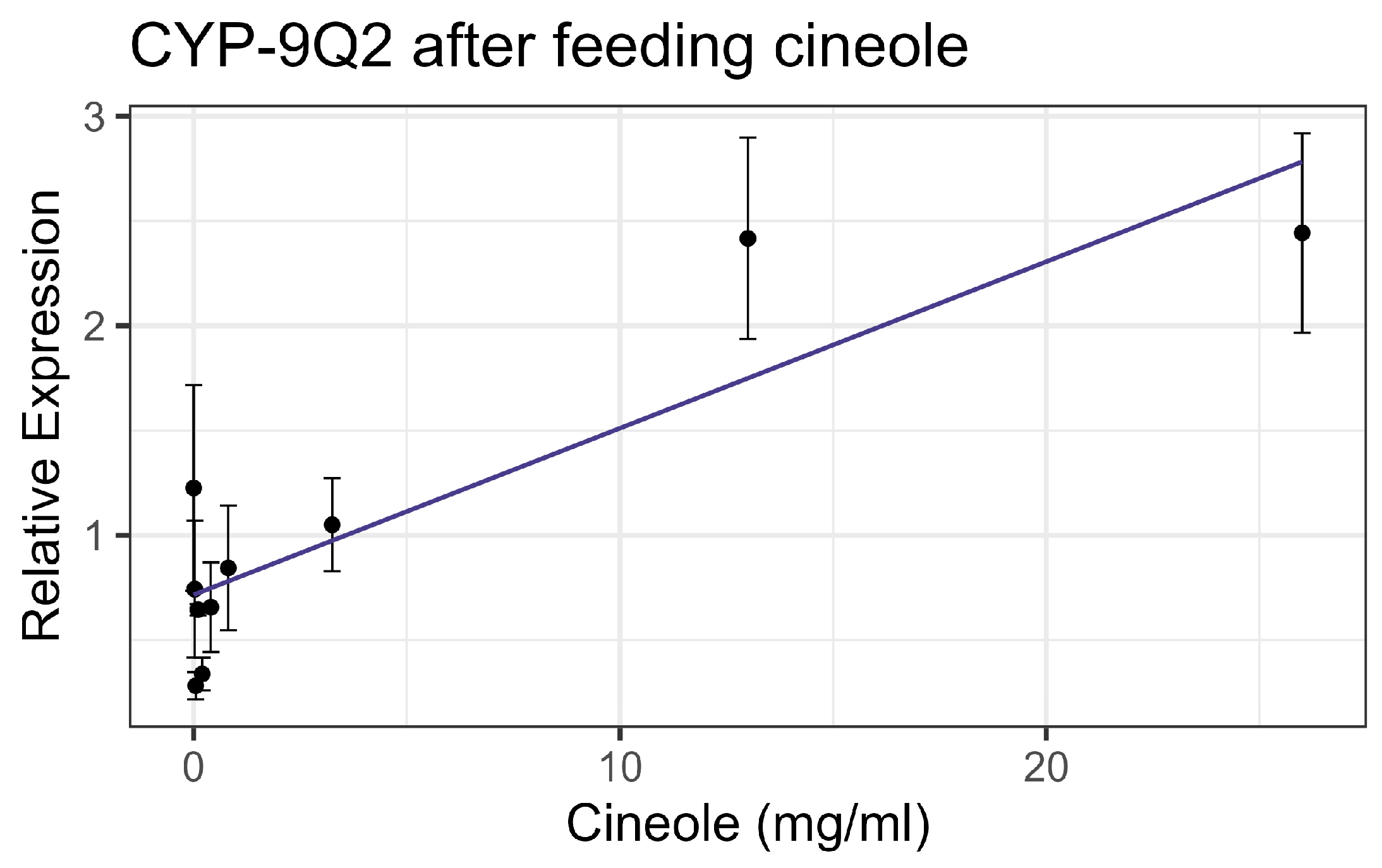
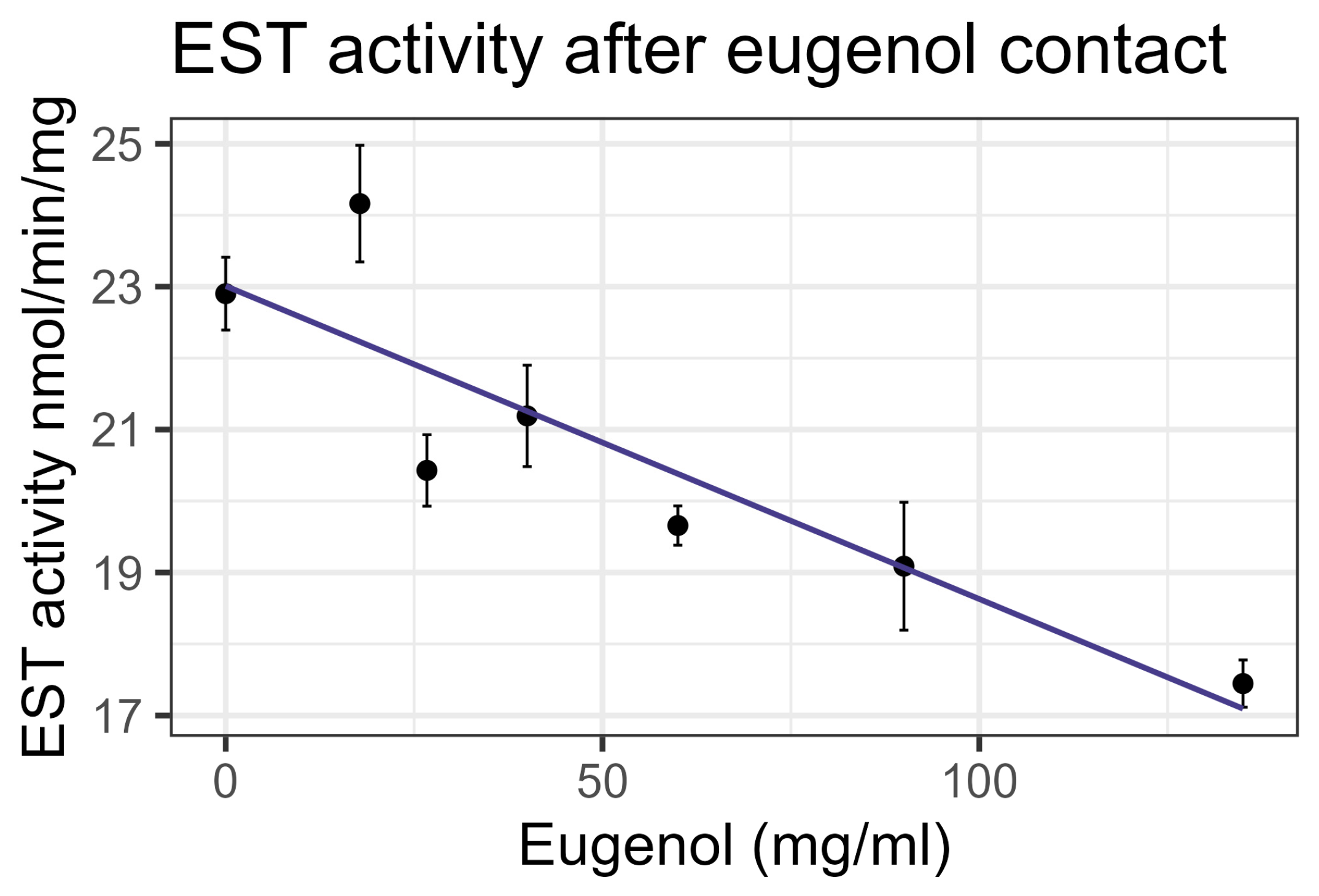
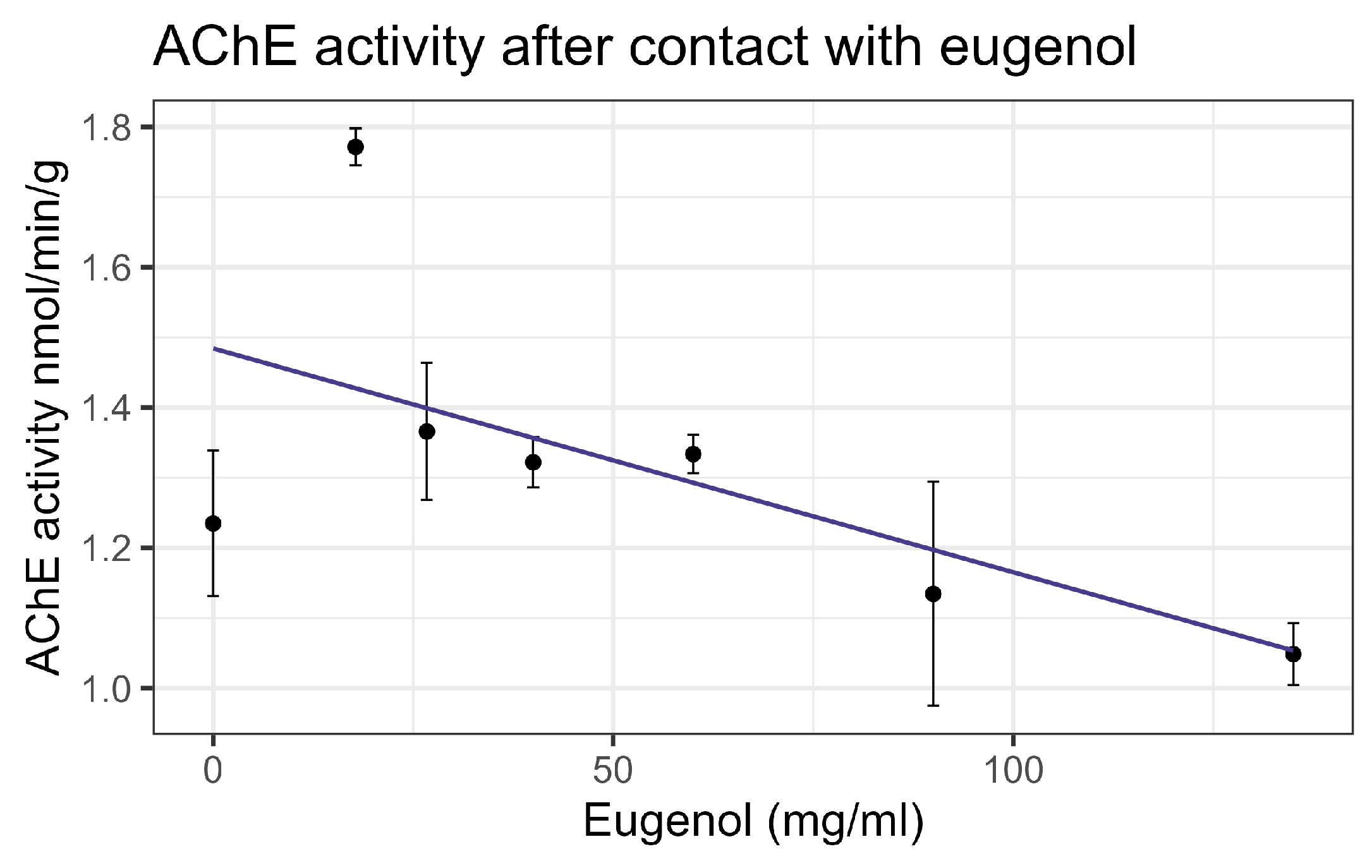
| Primer Name | Sequence |
|---|---|
| CYP-9Q1 (LOC408452) forward | CCACTCTGATAGGGTTGAAGAAG |
| CYP-9Q1 (LOC408452) reverse | TCGGTGAAGAACTTGGCTATG |
| CYP-9Q2 (LOC410492) forward | CAATTGAAGGAGCTGGGAAAG |
| CYP-9Q2 (LOC410492) reverse | CTCTATTGCGACAGCCTTTATTC |
| CYP-6AQ1 forward | AAACACACGTCAGCGGATAG |
| CYP-6AQ1 reverse | CCGAAGTAAAGACCGACGTAAG |
| CYP-6A13 (LOC727598) forward | CGGAACCTGAAGTATTCGATCC |
| CYP-6A13 (LOC727598) reverse | GATGCAATTTCTTGGCCCATC |
| Cinnamaldehyde, mg/mL | % Mortality, 48 h | SEM |
|---|---|---|
| 0.0 | 6.0 | 2.4 |
| 1.1 | 18.0 | 4.4 |
| 2.1 | 33.8 | 2.4 |
| 8.5 | 45.0 | 2.2 |
| 34.2 | 76.0 | 14.8 |
| 68.5 | 89.0 | 6.2 |
| Eugenol, mg/mL | % Mortality, 48 h | SEM |
|---|---|---|
| 0.0 | 0.0 | 0.0 |
| 16.9 | 0.0 | 0.0 |
| 26.7 | 15.0 | 15.0 |
| 33.8 | 12.5 | 7.5 |
| 40.0 | 12.5 | 7.2 |
| 60.0 | 45.0 | 7.4 |
| 67.5 | 31.3 | 16.0 |
| 90.0 | 86.7 | 13.3 |
| 135.0 | 90.0 | 5.0 |
Disclaimer/Publisher’s Note: The statements, opinions and data contained in all publications are solely those of the individual author(s) and contributor(s) and not of MDPI and/or the editor(s). MDPI and/or the editor(s) disclaim responsibility for any injury to people or property resulting from any ideas, methods, instructions or products referred to in the content. |
© 2025 by the authors. Licensee MDPI, Basel, Switzerland. This article is an open access article distributed under the terms and conditions of the Creative Commons Attribution (CC BY) license (https://creativecommons.org/licenses/by/4.0/).
Share and Cite
Caren, J.; Zhu, Y.-C.; Read, Q.D.; Du, Y. Risk Assessment of Effects of Essential Oils on Honey Bees (Apis mellifera L.). Insects 2025, 16, 303. https://doi.org/10.3390/insects16030303
Caren J, Zhu Y-C, Read QD, Du Y. Risk Assessment of Effects of Essential Oils on Honey Bees (Apis mellifera L.). Insects. 2025; 16(3):303. https://doi.org/10.3390/insects16030303
Chicago/Turabian StyleCaren, Joel, Yu-Cheng Zhu, Quentin D. Read, and Yuzhe Du. 2025. "Risk Assessment of Effects of Essential Oils on Honey Bees (Apis mellifera L.)" Insects 16, no. 3: 303. https://doi.org/10.3390/insects16030303
APA StyleCaren, J., Zhu, Y.-C., Read, Q. D., & Du, Y. (2025). Risk Assessment of Effects of Essential Oils on Honey Bees (Apis mellifera L.). Insects, 16(3), 303. https://doi.org/10.3390/insects16030303






